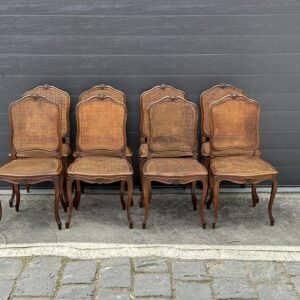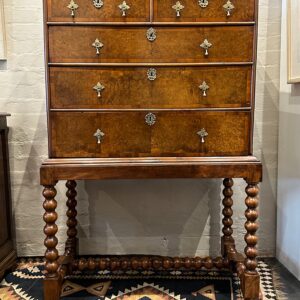Showing 49–64 of 169 resultsSorted by latest
An exceptional rare early 19th Century English elm writing bureau AA1895
The gallery moulded top and lifting lid above a four short and three long slight graduated drawers, resting on bun feet.
Having a fantastic overall faded colour and patination.
With later but appropriate brasswork.
C. 1820
H: 88 cm W: 82 cm D: 43.5 cm
A rare 17th century English ash boarded chest of diminutive proportions.
The knuckle hinged top, with an applied carved fruitwood facing mould, above the incised/scratch-carved feeding birds. With traces of the original hand made nails and missing lock plate.
The floor wedged through the end boards, with arches resembling legs.
C.1680
AA2365
Primitive first half 19th century English hoop wheel back Windsor arm-chair.
Ash, fruitwood and elm.
The thick two plank slight saddle seat, resting on unusual turned legs, joined by a turned ‘H’ stretcher.
Thames Valley 1800 – 1840
Wonderful deep oak colour and patination.
H.86cm W.52cm D.50cm
$1,800 reduced to $900
Early 19th century English oak lowboy.
A most beautiful 19th century French green chinoiserie display cabinet of narrow proportions
The rectangular moulded top, above two long hinged doors, opening to reveal a cord covered interior, with a small light above each shelf.
The doors having a double throw lock.
With narrow glassed viewing sides, resting on short turned tapered legs.
18th century English Oak refectory/sofa/side table
The well patinated thick, single plank top above a rectangular moulded skirt, resting on well-turned legs, joined by bold stretchers.
H.76cm
W.151cm
D.74cm
Complete set of eight English Hepplewhite revival dining chairs, including two armchairs.
A great find.
The moulded bowed floral carved top rail, with tapered side supports and beautifully carved rear splat.
Having comfortable wide upholstered seats, resting on square moulded tapered legs.
19th century English pewter potty.
Used in displays for over 30 years.
H.11cm W.29cm
19th century English floral gilt decorated & painted tin tray on original black painted folding stand.
The shaped moulded edge retaining much of the original gilt design.
The painted surface includes a peacock and flowers.
Fantastic condition. Cleaned and waxed in our workshop this morning.
C.1890
H.44cm
W.78cm
D.59cm
17th Century English Oak Livery Cupboard – AA1664
A Nest of English Oak Tables
This nest of 1920s oak side tables have been around for many many years.
I purchased them around 15 years ago, my late father Neville stripped the lacquered finish off for me, for some reason he removed all the tops?
So over the years, we found some tops, the bases, moved from store to storeroom, bloody bloody!!
19th Century English ‘William & Mary’ style, Yew & Walnut Chest on Stand.
A recent purchase from another dealer.
The chest had been coloured to a dark green oak and had been lacquered.
I could tell there was something more special beneath that finish.
As soon as we started cleaning it back, we discovered the Yew wood cross-banding then the solid Yew wood base.
Such a wonderful discovery!
First half 19th Century English faded Rosewood sofa/side table
The figured book matched, rectangular top above two narrow drawers.
Retaining the original turned handles, on a well turned, finely carved decorative base.
C.1830
H.74cm
W.122cm
D.61cm
A rare early 18th century George I wild figured country walnut chest of drawers.
A rare set of six 1920s revival dining chairs.
These chairs are around 100 years old. The 20s was a huge revival period.
They have Queen Anne rear shaped splats and shaped top rails 1705.
George I and George II cavletto style moulds 1714 – 1740
all blending so well.
Would you believe I used bitumen to build this beautiful walnut/period oak colour.
A long, complicated, somewhat monotonous restoration job indeed!
Photographed by Russell Winnell.















